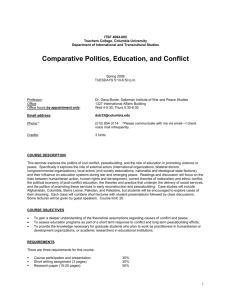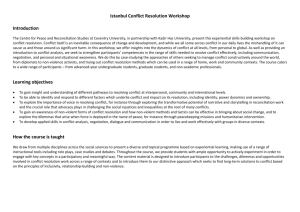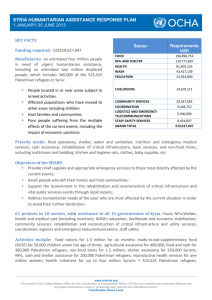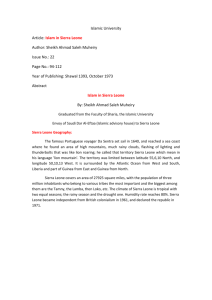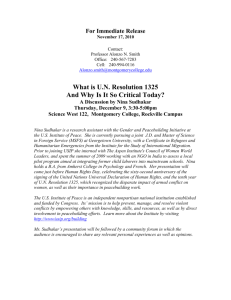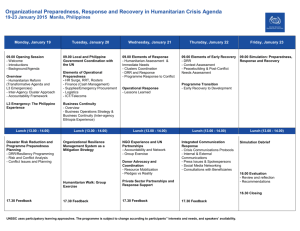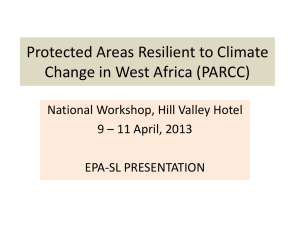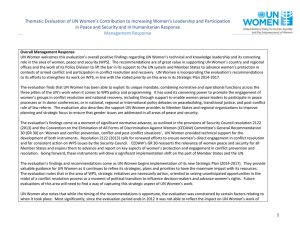Comparative Politics, Education, and Conflict
advertisement
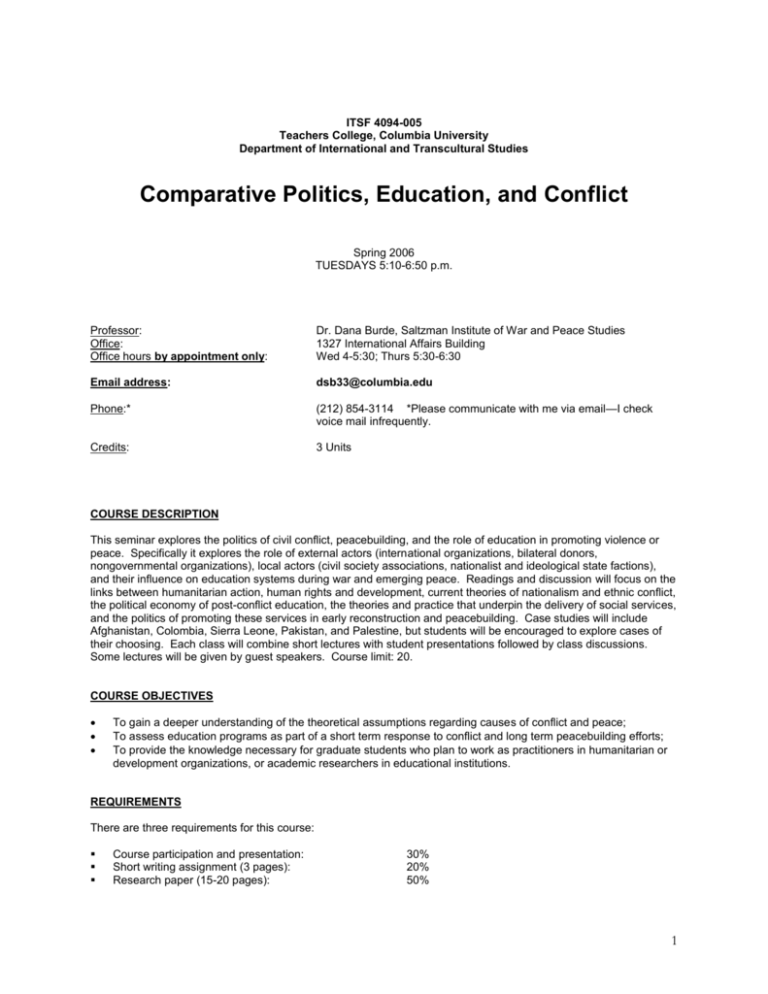
ITSF 4094-005 Teachers College, Columbia University Department of International and Transcultural Studies Comparative Politics, Education, and Conflict Spring 2006 TUESDAYS 5:10-6:50 p.m. Professor: Office: Office hours by appointment only: Dr. Dana Burde, Saltzman Institute of War and Peace Studies 1327 International Affairs Building Wed 4-5:30; Thurs 5:30-6:30 Email address: dsb33@columbia.edu Phone:* (212) 854-3114 *Please communicate with me via email—I check voice mail infrequently. Credits: 3 Units COURSE DESCRIPTION This seminar explores the politics of civil conflict, peacebuilding, and the role of education in promoting violence or peace. Specifically it explores the role of external actors (international organizations, bilateral donors, nongovernmental organizations), local actors (civil society associations, nationalist and ideological state factions), and their influence on education systems during war and emerging peace. Readings and discussion will focus on the links between humanitarian action, human rights and development, current theories of nationalism and ethnic conflict, the political economy of post-conflict education, the theories and practice that underpin the delivery of social services, and the politics of promoting these services in early reconstruction and peacebuilding. Case studies will include Afghanistan, Colombia, Sierra Leone, Pakistan, and Palestine, but students will be encouraged to explore cases of their choosing. Each class will combine short lectures with student presentations followed by class discussions. Some lectures will be given by guest speakers. Course limit: 20. COURSE OBJECTIVES To gain a deeper understanding of the theoretical assumptions regarding causes of conflict and peace; To assess education programs as part of a short term response to conflict and long term peacebuilding efforts; To provide the knowledge necessary for graduate students who plan to work as practitioners in humanitarian or development organizations, or academic researchers in educational institutions. REQUIREMENTS There are three requirements for this course: Course participation and presentation: Short writing assignment (3 pages): Research paper (15-20 pages): 30% 20% 50% 1 I. PARTICIPATION (30%): 1) 2) 15% for attendance and participation in discussions. The course requires the participation of all class members through discussion and debate. You are expected to come to class prepared to discuss all of the required readings. 15% for group presentation. In addition to participating actively in discussions, you will be asked to organize one presentation with another colleague. You are required to email your presentation outline to me on the Monday morning prior to class; I will review it and send comments or suggestions. In the presentation, you will be evaluated for content, creativity, and pedagogy. II. SHORT WRITING ASSIGNMENT (20%) Choose one set of readings during the first eight sessions about which to write a short paper (3 pp., double-spaced). This paper should examine some theoretical aspect of the readings, providing a brief critical reflection, or analysis of the ideas presented in them. III. RESEARCH PAPER (50%) DUE APRIL 21ST AT 4 PM After the first four weeks of the course, you will be required to identify a research topic among the topics covered in the course, broadly defined. I would like you to use this paper as an opportunity to explore a topic that you find particularly compelling. Although it is not required, I encourage you to use primary as well as secondary sources. In other words, you should feel free to conduct interviews with current or former colleagues, or with contacts that you develop in aid or development organizations. I will ask that you submit an abstract to me on March 7 (via email, before class), describing why your topic is important, your main argument, and sources (primary and/or secondary). I encourage both doctoral and master’s students to use this exercise to explore topics for your dissertation proposal, or master’s thesis, respectively. You will receive a more detailed description of this assignment on January 31. NOTE: Please submit all assignments to me via email at: dsb33@columbia.edu. You will receive comments and feedback via email as well. This means that I will use the editing functions under “tools,” “track changes” to write comments and suggestions into your papers using highlighted text. RECOMMENDED BOOKS TO PURCHASE Donnelly, J. (2003). Universal human rights in theory and practice. Ithaca, NY: Cornell University Press. Duffield, M. (2002). Global Governance and the New Wars: The Merging of Development and Security. London: Zed Books. Stedman, S. J., Rothchild, D., & Cousens, E. (eds). Ending civil wars: The implementation of peace agreements. Boulder: Lynne Rienner Publishers. Terry, F. (2002). Condemned to repeat? The paradox of humanitarian action. Ithaca, NY: Cornell University Press. 2 COURSE SCHEDULE NOTE: Some readings—mainly news items—may be added to the following list. Session 1, January 24: Banks, M. (1987). Four Conceptions of Peace, in Dennis Sandole and I.S. Sandole (eds), Conflict Management and Problem Solving, Pinter. Burde, D. (December 2005). Education in Crisis Situations: Mapping the Field. Washington, DC: Creative Associates/Basic Education Support Project, United States Agency for International Development. Available: http://www.beps.net/beps_pubs.htm or via class web. Galtung, J. (1969). Violence, peace and peace research, Journal of Peace Research. 6 (167-191). Human Security Center. (2005). Human Security report from UBC. Chapter one: The changing face of violence. Session 2, January 31: Religion Moghadam, A. (August 2003). A global resurgence of religion? Weatherhead Center for International Affairs Working Paper No. 03-03. Stark, R. (Fall 1999). Secularization, R.I.P. (Rest in peace). Sociology of Religion 60(3) 249-73. Juergensmeyer, M. (1993). The new Cold War? Religious nationalism confronts the secular state. Ch. introduction, 1, and conclusion. Stern, J. (Jul/Aug 2003). The protean enemy. Foreign Affairs. 82(4). Perlez, J. (October 12, 2003). Enlisting aid to education in the war on terror. New York Times. Session 4, February 14: Ethno-Nationalism: Definitions, Causes, Consequences Petersen, R. (2002). Understanding ethnic violence: Fear, hatred, resentment. Ch. 1-3. Hechter, M. (2000). Containing Nationalism. Ch. 1. Nationalist puzzles. Smith, A. D. (1986). The Ethnic Origins of Nations. ch. 1-3 Lake, D. & Rothchild, D. (1996). Containing fear: The origins and management of ethnic conflict, in Michael E. Brown, ed., Nationalism and Ethnic Conflict. Session 3, February 7: Introduction: War, peace, and education in emergencies Political economy Guest speaker: Karen Ballentine, Consultant on Political Economy of Armed Conflict Ballentine, K. & Sherman, J. (2003). The political economy of armed conflict: Beyond greed and grievance. Boulder: Lynne Riennner. Ch. 3 and 10. Berdal, M. & Malone, D. (2000). Greed and grievance: Economic agendas in civil wars. Ch. 5,10. Humphreys, M. (2005). Natural resources, conflict, and conflict resolution: Uncovering the mechanisms, Journal of Conflict Resolution 2005 49/4: 508-537. Woodward, S. (2002). Economic priorities for successful peace implementation, in Stephen John Stedman, Donald Rothchild & Elizabeth Cousens (eds). Ending civil wars: The implementation of peace agreements. Boulder: Lynne Rienner Publishers, 183-214. Session 5, February 21: Beyond the continuum: Humanitarian aid versus Development De Waal, A. (1997). Famine crimes: Politics and the disaster relief industry in Africa. Ch: 3 Neoliberalism and adjustment, 4 The humanitarian international, and 11 Conclusion. Duffield, M. (2002). Global Governance and the New Wars: The Merging of Development and Security. London: Zed Books. Ch 1 and 2. Harmer, A. & Macrae, J. (2004). Beyond the continuum: The changing role of aid policy in protracted crisis. London: Overseas Development Institute. Terry, F. (2002). Condemned to repeat? The paradox of humanitarian action. Ithaca, NY: Cornell University Press. Ch. 1, 6 Session 6, February 28: Human Rights Guest Speaker: Iain Levine, Program Director Human Rights Watch Donnelly, J. (2003). Universal human rights in theory and practice. Ithaca, NY: Cornell University Press. Ch. 1,2, 6. 3 Putnam, T. (2002). Human rights and sustainable peace, in Implementing Peace Agreements, pp. 237-273 (Chapter 9) ICVA. (2003). Frequently asked questions on International Humanitarian, Human Rights and Refugee Law in Growing the sheltering tree: Protecting human rights through humanitarian action. Available online at: http://www.icva.ch/cgi-bin/browse.pl?doc=doc00001023 Session 7, March 7: Peacebuilding and global governance ABSTRACT DUE (via email) Paris, R. (2004). At War’s End: Building Peace after Civil Conflict. Cambridge: Cambridge University Press. Introduction and Ch. 1. Stedman, S. J. (2002). Introduction, in Stephen John Stedman, Donald Rothchild and Elizabeth Cousens (eds). Ending Civil Wars: The Implementation of Peace Agreements. Boulder: Lynne Rienner Publishers. Chapters 1, 2, 3 Pugh, M. (2000). Introduction: The Ownership of Regeneration and Peacebuilding, in Michael Pugh, (ed). Regeneration of War-Torn Societies. New York: St. Martin’s Press. Cockell, J. (2000). Conceptualizing peacebuilding: Human security and sustainable peace, in Michael Pugh, (ed). Regeneration of War-Torn Societies. New York: St. Martin’s Press. Session 8, March 14: SPRING BREAK Session 9, March 21: During and Post-conflict delivery of social services Berry, C. et al. (October 2004). Approaches to improving the delivery of social services in difficult environments. Poverty reduction in difficult environments team, UK Department for International Development. OECD. (15 June 2005). Service delivery in fragile states. World Bank (2004). World development report: Making services work for poor people. Skim the whole report but give particular attention to ch. Overview, 1-3, and 7. Session 10, March 28: Case study: Afghanistan Cramer, C. & Goodhand, J. (2002). Try again, fail again? State formation and reconstruction in Afghanistan. Development and Change. 33(5). General Accounting Office. (July 2005). Afghanistan reconstruction: Despite some progress deteriorating security and other obstacles continue to threaten achievement of U.S. goals. World Food Programme. (April 2005). Results and discussion of the education data collected in the Afghanistan national risk and vulnerability assessment 2003. Hunte, P. (December 2005). Household decision-making and school enrolment in Afghanistan: Case study in Kabul. Afghan Research and Evaluation Unit. Asian Development Bank. (April 2003). A new start for Afghanistan’s education sector. Session 12, April 11: Guest speaker: Ignacio Saez-Benito, Early Warning Specialist, UNICEF OECD. (2001). The DAC guidelines: Helping prevent violent conflict. Skim through report, giving special attention to Part One. Joseph, T. & Carment, D. (2000). Early warning methods. Country Indicators for Foreign Policy, Carleton University. International Crisis Group Early Warning Resources. Familiarize yourself with these resources: http://www.crisisgroup.org/home/index.cfm?id=3397&l=1; Also: http://www.carleton.ca/cifp/ Session 11, April 4: Conflict prevention Case Study: Pakistan Armanios, F. (October 2003). Islamic religious schools, madrasas: Background. Congressional Research Service. Gall, C & Khan, M. (January 22, 2006). Pakistan’s push in border area is said to falter. New York Times. International Crisis Group. (October 2004). Pakistan: Reforming the education sector. Singer, P. W. (November 2001). Pakistan’s madrassahs: Ensuring a system of education not jihad. Brookings Institution. Terry, F. (2002). Condemned to repeat? The paradox of humanitarian action. Ithaca, NY: Cornell University Press. Ch. 2. 4 Rahman, K. & Bikhari, S. R. (2004). Religious education institutions (REIs): Present situation and future strategy. Islamabad, Pakistan: Institute of Policy Studies. Session 13, April 18: Case study: Palestine Abu-Saad, I. & Champange, D. (April 2006). A historical context of Palestinian Arab education. American Behavioral Scientist. 49(8), 1035-1051. Khalidi, R. (1997). Palestinian Identity: The Construction of Modern National Consciousness. New York: Columbia University Press. chapter 2 (“Contrasting Narratives of Palestinian Identity,” pp. 9-33). Plonski, S. (December 2005). Developing agency through peacebuilding in the midst of intractable conflict: The case of Israel and Palestine. Compare. 35(4), 393-409. Rosenfeld, M. (2002). Power structure, agency, and family in a Palestinian refugee camp. International Journal of Middle East Studies. 34, 519-551. Sukharieh, M. (Autumn 1999). Through children’s eyes: Children’s rights in Shatila camp. Journal of Palestinian Studies. 29(1), 50-57. Optional: Sletten, P. & Pedersen, J. (2003). Coping with conflict: Palestinian communities two years into the intifada. Fafo Institute for Applied International Studies. United Nations Relief Works Agency. (2000). Education statistics. UNRWA Headquarters, Gaza. United Nations Relief Works Agency. (2005). Emergency appeal. UNRWA Headquarters, Gaza. *****FRIDAY APRIL 21ST 4PM FINAL PAPER DUE***** Session 14, April 25: Case study: Sierra Leone Krech, R. & Maclure, R. (2004). Education and human security in Sierra Leone: Discourses of failure and reconstruction. In Comparative education, terrorism, and human security: From critical pedagogy to peacebuilding? New York: Palgrave Macmillan. Richards, P. (1996). Introduction, in Fighting for the rain forest. Keen, D. (2005). Grievance and shame, in Conflict and collusion in Sierra Leone. Humphreys, M. & Weinstein, J. (July 2004). What the fighters say: A survey of ex-combatants in Sierra Leone, June-August 2003. Columbia University, Stanford University and the Post-Conflict Reintegration Initiative for Development and Empowerment. Available: http://www.columbia.edu/~mh2245/SL.htm Optional: Take a look at the following websites: www.witness.org and Campaign for Good Governance: www.slcgg.org/home.htm Read this short article on civic education in Sierra Leone: http://www.usaid.gov/sl/sl_democracy/news/030718_ndicivforum/ And this evaluation of a USAID Office of Transition Initiatives youth reintegration program: http://www.beps.net/publications/FINAL%20EVALUATION%20OF%20OTI%20PROGRAM%20IN%20SIERRA% 20LEONE.PDF Session 15, May 2: Case study: Colombia Guaqueta, A. (2003). The Colombian conflict: Political and economic dimensions. In K. Ballentine and J. Sherman (eds) The political economy of armed conflict: Beyond greed and grievance. Bernal, E. C. (1997). Colombia: Country and schools in conflict. In Sobe Tawil (ed.), Final report and case studies of the Workshop on Educational Destruction and Reconstruction in Disrupted Societies. Geneva: International Bureau of Education, UNESCO. Hanson, E. M, (February 1995). Democratization and decentralization in Colombian education. Comparative Education Review. Special Issue on Education in Latin America. 39(1), 101-119. Eaton, K. (2005). The unintended consequences of decentralization: Armed clientelism in Colombia. Paper delivered at the American Political Science Association annual conference. Watchlist. (2004). Colombia’s war on children. New York: Women’s Commission for Refugee Women and Children. 5 Optional: International Crisis Group. (June 2005). Colombia: Presidential political and peace prospects. Latin America report # 14. Useful Resources: Human Rights Watch: http://www.hrw.org/ The Human Security Center: http://www.humansecuritycentre.org/ International Crisis Group home page: http://www.crisisgroup.org/home/index.cfm?l=1 Research resources and links: http://www.crisisgroup.org/home/index.cfm?l=1&id=1130 International Peace Academy: http://www.ipacademy.org/ Overseas Development Institute: http://www.odi.org.uk/ 6
